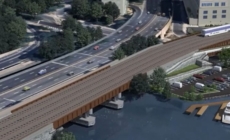-
Red Sox Star Jarren Duran Offers 4-Word Response on Lost Playing Time - 9 mins ago
-
A Surgeon Shares What She Saw in Gaza’s Hospitals - 40 mins ago
-
Supreme Court Deals Blow to Republican Immigration Law in Florida - 44 mins ago
-
Jeffrey Epstein’s Brother Reacts to Trump Administration’s Review of Case - about 1 hour ago
-
Body found inside a Goodwill donation bin in Pasadena - about 1 hour ago
-
X CEO Linda Yaccarino Says She Is Leaving Elon Musk’s Platform - about 1 hour ago
-
$1 Billion Washington, DC, Rail Bridge Project Moves Forward - 2 hours ago
-
Fireworks warehouse explosion: Authorities search home of CEO - 2 hours ago
-
Israel Launches New Ground Incursion in Lebanon, Raising Fears for Truce - 2 hours ago
-
Vikings Linked to Major Roster Move Ahead of Training Camp - 2 hours ago
NJ Transit Strike: Map Shows Alternate Routes to Avoid Chaos
Rail service across New Jersey ground to a halt on Friday after workers began strike action, leading to major disruptions for hundreds of thousands of commuters.
The action followed the breakdown of labor negotiations between New Jersey Transit and the unions representing its rail workers, many of whom say they have been working without a pay rise for five years.
The strike began shortly after midnight on Friday, affecting more than 300,000 daily riders who rely on NJ Transit’s extensive rail network. The shutdown affects almost all commuter train service in the state.
The two sides had initially agreed to a “cooling off” period of 30 days in April. When that ended, the union proceeded with the strike as no agreement had been reached.
In a news conference held on Thursday night, New Jersey Governor Phil Murphy told reporters, “Let’s get back to the table and seal a deal, and let’s move forward on meeting our most important responsibility of all: serving the needs of New Jerseyans who rely on NJ Transit.”
“We must reach a final deal that is both fair to employees and at the same time affordable for New Jersey’s commuters and taxpayers. Again, we cannot ignore the agency’s fiscal realities,” Murphy added.
How Long Will the Strike Last?
There is currently no end date for the strike. Union leaders and NJ Transit management remain divided over core issues, including wage increases and cost-of-living adjustments.
Both sides held last-minute talks on Thursday—following a meeting with the National Mediation Board in Washington, D.C., on Monday—but failed to reach a deal.

Seth Wenig/AP Photo
What Alternative Routes Are Available?
Regular NJ Transit bus routes are set to continue running as scheduled, offering critical alternatives for stranded riders. The Hudson-Bergen Light Rail, Newark Light Rail and River Line services also remain operational on regular weekday timetables.
The map below shows weekday bus services that commuters can use to travel between New York and New Jersey.

NJ Transit
With all NJ Transit rail service suspended, the agency is implementing a limited contingency plan. Some additional capacity is being added to existing New York-bound bus routes, and a park-and-ride system is set to operate on weekdays, beginning on May 19, from key locations—including Secaucus Junction, PNC Bank Arts Center, Hamilton Station and Woodbridge Center Mall.
However, the agency has acknowledged the limitations of its backup plans, saying on its website: “Through a combination of added capacity to existing New York bus routes, operation of a regional Park & Ride service, NJ TRANSIT estimates that it can only carry approximately 20 percent of current rail customers as the bus system capacity can not replace the railroad.”
Commuters are being advised to work from home or limit travel to essential purposes where possible. PATH trains, ferries and ride-sharing platforms are likely to see increased demand, while transit systems in New York are managing an uptick in cross-Hudson passengers.
What Happens Next
Murphy has said all options are on the table, including calling a state of emergency.
No federal intervention has been announced, though such involvement remains possible if the disruption escalates or interferes with interstate commerce.
Congress has the authority under the Railway Labor Act to impose a settlement on both parties, even if the union membership has rejected the proposed agreement.
Commuters are urged to check NJ Transit’s strike information hub regularly for updates.
Source link



















